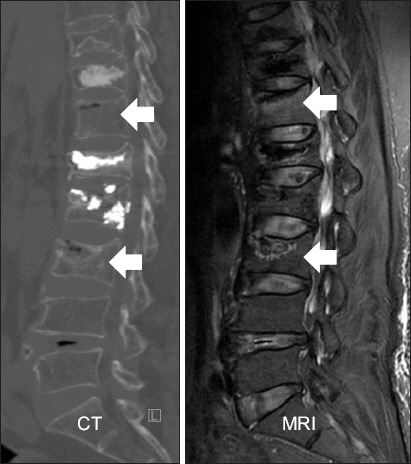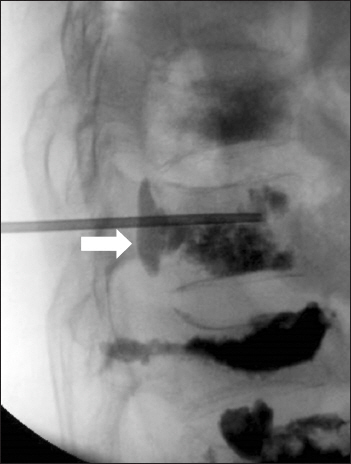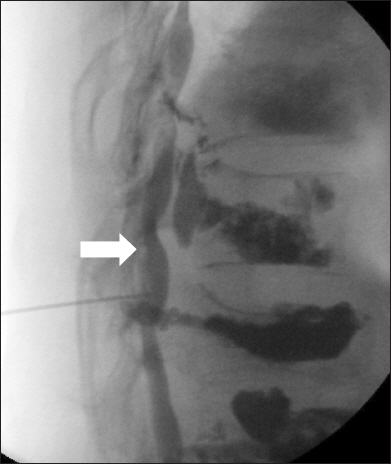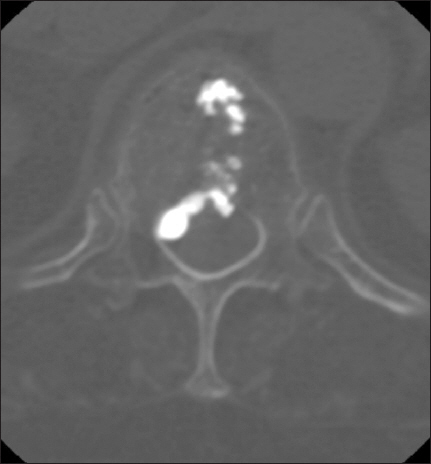Anesth Pain Med.
2018 Jan;13(1):93-97. 10.17085/apm.2018.13.1.93.
Therapy of thermal injury due to bone cement leakage by cooled normal saline irrigation through epidural catheterization: A case report
- Affiliations
-
- 1Department of Anesthesiology and Pain Medicine, Kyungpook National University Hospital, Daegu, Korea.
- 2Department of Anesthesiology and Pain Medicine, Kyungpook National University Chilgok Hospital, Daegu, Korea. pjm4013@naver.com
- KMID: 2436062
- DOI: http://doi.org/10.17085/apm.2018.13.1.93
Abstract
- A 72-year-old woman was diagnosed with Kümmell's disease of the T12 and L3 vertebrae. During bone cement injection under continuous fluoroscopic guidance, bone cement spread beyond the posterior border of the T12 vertebral body. We halted the injection immediately. A few minutes later, the patient complained of increasing right lower quadrant abdominal pain. This was diagnosed as a preceding sign of neurological complication due to thermal injury. Consequently, we administered an epidural steroid injection, followed by cooled normal saline irrigation through an epidural catheter to minimize and treat the thermal injury. The pain gradually decreased after saline irrigation and completely disappeared after approximately 10 minutes. After completing the percutaneous vertebroplasty, the patient's lower back pain improved without neurological complications. In conclusion, immediate epidural steroid injection followed by cooled normal saline irrigation through epidural catheterization can be used to treat thermal injury due to bone cement leakage.
Keyword
MeSH Terms
Figure
Reference
-
1. Anderson SR. Vertebroplasty. Pain Pract. 2001; 1:46–52. DOI: 10.1111/j.1533-2500.2001.01006.x. DOI: 10.1046/j.1533-2500.2001.01006.x. PMID: 17129283.2. Park JM. Interventional treatments for cancer pain due to bone metastasis. Anesth Pain Med. 2015; 10:149–164. DOI: 10.17085/apm.2015.10.3.149.3. Yeom JS, Kim WJ, Choy WS, Lee CK, Chang BS, Kang JW. Leakage of cement in percutaneous transpedicular vertebroplasty for painful osteoporotic compression fractures. J Bone Joint Surg Br. 2003; 85:83–9. DOI: 10.1302/0301-620X.85B1.13026. PMID: 12585583.4. Schmidt R, Cakir B, Mattes T, Wegener M, Puhl W, Richter M. Cement leakage during vertebroplasty: an underestimated problem? Eur Spine J. 2005; 14:466–73. DOI: 10.1007/s00586-004-0839-5. PMID: 15690210. PMCID: PMC3454665.5. Belkoff SM, Molloy S. Temperature measurement during polymerization of polymethylmethacrylate cement used for vertebroplasty. Spine (Phila Pa 1976). 2003; 28:1555–9. DOI: 10.1097/00007632-200307150-00015.6. Lai PL, Tai CL, Chen LH, Nien NY. Cement leakage causes potential thermal injury in vertebroplasty. BMC Musculoskelet Disord. 2011; 12:116. DOI: 10.1186/1471-2474-12-116. PMID: 21615939. PMCID: PMC3124425.7. Galibert P, Deramond H, Rosat P, Le Gars D. Preliminary note on the treatment of vertebral angioma by percutaneous acrylic vertebroplasty. Neurochirurgie. 1987; 33:166–8. PMID: 3600949.8. Hulme PA, Krebs J, Ferguson SJ, Berlemann U. Vertebroplasty and kyphoplasty: a systematic review of 69 clinical studies. Spine (Phila Pa 1976). 2006; 31:1983–2001. DOI: 10.1097/01.brs.0000229254.89952.6b. PMID: 16924218.9. Ryu KS, Park CK, Kim MC, Kang JK. Dose-dependent epidural leakage of polymethylmethacrylate after percutaneous vertebroplasty in patients with osteoporotic vertebral compression fractures. J Neurosurg. 2002; 96(1 Suppl):56–61. DOI: 10.3171/spi.2002.96.1.0056.10. Uchiyama S, Yashiro K, Takahashi H, Homma T. An experimental study of spinal cord evoked potentials and histologic changes following spinal cord heating. Spine (Phila Pa 1976). 1989; 14:1215–9. DOI: 10.1097/00007632-198911000-00014.11. Wilkes RA, Mackinnon JG, Thomas WG. Neurological deterioration after cement injection into a vertebral body. J Bone Joint Surg Br. 1994; 76:155. DOI: 10.1302/0301-620X.76B1.8300663. PMID: 8300663.
- Full Text Links
- Actions
-
Cited
- CITED
-
- Close
- Share
- Similar articles
-
- Thermal Injury During the Microvascular Free Flap: A Case Report
- Anterior Epidural Irrigation in Patient with Lumbar Spinal Stenosis: A case report
- Anterior Epidural Irrigation in a Lumbar Spinal Stenosis Patient
- The Breakage of Epidural Catheter during Continuous Epidural Analgesia for Cancer Pain: A case report
- Fatal Hemothorax Following Percutaneous Vertebroplasty: A Case Report





